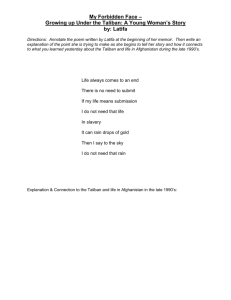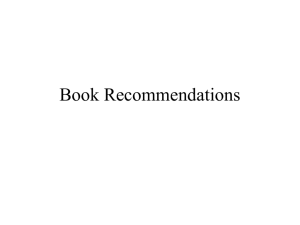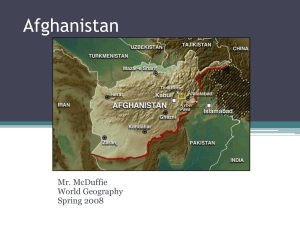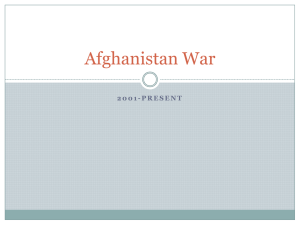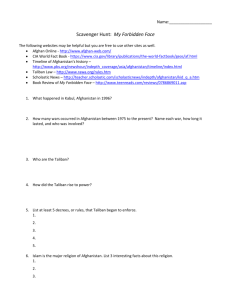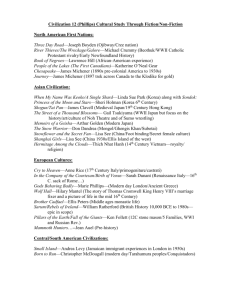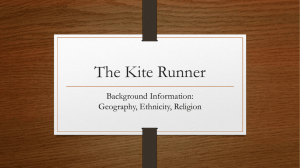Afghanistan
advertisement
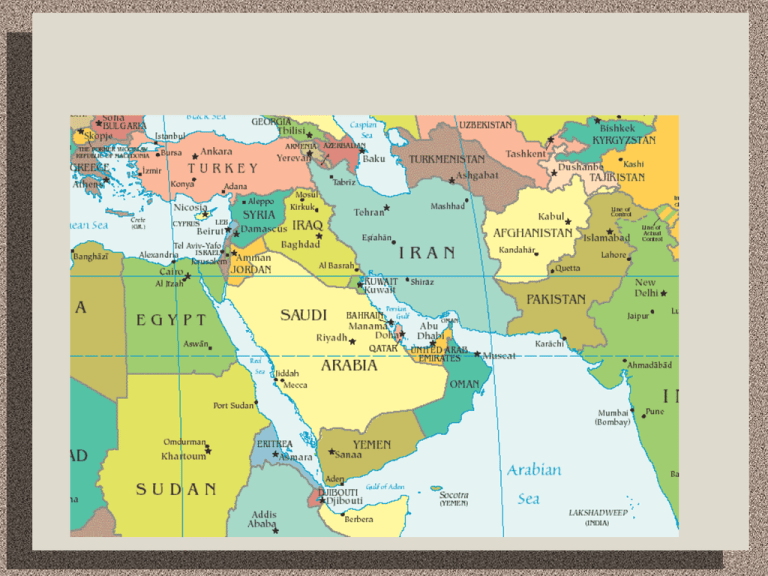
To understand today’s troubles we have to go back – way back. There have been 4 attempts to invade and control its people. 1). Alexander the Great 320 B.C.E. 2). Genghis Khan 1200 C.E. 3). The British Empire (3 times)! 4). The Soviet Union Alexander the Great • - Led the world’s largest army across the known world, conquering every empire in his path. • - Died in Babylon (Iraq) on his way home at 32. • - On his death bed whispered his last words: "I defeated the Persians, and I swung through the Pyramids, But, I wept in Bactria" (ancient name for Afghanistan) Genghis Khan • Well known as a bad dude. Remembered for his willingness to kill EVERYONE! • While he had some success in Afghanistan it was the only place his empire couldn’t hang on to. The British Empire Afghanistan 1842, 1880, 1919. According to Professor Dean Wright of Oxford University, “The British Empire never wanted to conquer Afghanistan. Only to help establish a better government” (Constant internal tribal fighting). On one offensive in the Anglo-Afghan War in 1842, 20,000 British troops left Kabul for battle, 1 man named Dr. W. Brydon returned. The Brits returned in 1880 to attempt to control the influence of Russia in Afghanistan. (Remember, the Brits control India at this time) Brits allowed Afghanistan to control their own domestic policies, but Brits controlled their foreign affairs. Eventually, the Brits lose again. By 1919 the British were already fighting in WWI and had no appetite for another fight with the Afghans when they invaded India and signed a peace agreement. http://www.friedgold.co.uk/battles.html Three Cups of Tea? • When the British left India in 1947, they set the modern borders of Afghanistan, Pakistan, and India. • Many people in this region do not recognize these borders as legitimate. • Three Cups of Tea: Kashmir Region – still occupied by China, India and Pakistan. (Nuclear weapons) Ethnic Groups Map Pashtun: largest ethnic group, mostly farmers and Sunni Muslims Tajik: live mostly in the northeast, second largest ethnic group, mostly Sunni Muslims Hazara: live in the Hindu Kush mountains, primarily Shiite Muslims Uzbek: live mostly along the northern border, mostly Sunni Muslims Aimaqs: a farming and herding tribe in the west, mostly Sunni Muslims Turkmen and Kirghiz: nomadic herders and craftsmen, mostly Sunni Muslims Over 30 languages are spoken in Afghanistan. Baluch: nomadic tribe living in the southern deserts, Sunni Muslims What do all of these nations have in common? They were all the biggest army in the world at the time of their involvement in Afghanistan. They relied on huge shows of military force using advanced military technology and brute force. They underestimated the power of the tribal groups of this region. Each new invader brought new religious beliefs. Losses: Geography and tribal infrastructure. The Soviets • USSR invades Afghanistan to support the communist government against Northern India. • The US helps the Mujahadeen overthrow the USSR – why? • 1979 was during the Cold War, a time when the USA was a rival to the Soviet Union. The USA wanted to help Afghans fight the Soviets. • The CIA sent stinger missiles to Afghans to shoot down Soviet helicopters. Mujahadeen“The Freedom Fighters” -Using guerilla tactics, Mujahedeen fighters destroyed both military and civilian targets like bridges, roads and buildings. - They assassinated key military and political leaders. New Opportunities for the Mujahedeen While the money and training Afghan rebels received from places like the U.S., Great Britain and Saudi Arabia made a big difference it was not the most lasting effect of this war. The Soviet invasion of Afghanistan had many lasting effects. 1). Some of these include: Nearly 1.5 million undetonated land mines. Some statistics say that up to 1 in every 5 children have lost a limb to unexploded mines and artillery. Mines shaped like toys. 2). Afghanistan has the distinct honor of having one of the highest numbers of orphans in any country. This is a result of nearly constant war since 1979. Life expectancy is 45 years. Lasting effects of the Soviet Invasion 3). A generation of Afghan children orphaned by the war with little guidance, education or support. The Result: A perfect place to be recruited by groups like the Taliban and Al Qaeda (Madrassas) Lasting Effects of the Soviet Invasion 4). The Birth of Global Jihad The single most lasting effect of the invasion by the Soviet Union was the gathering of Islamic fighters to the cause of defending their version of Islam. The Fight for Control of Afghanistan After the final Soviet troops left in 1989, the battle for who would run Afghanistan began. Rise of the Taliban According to our experts on the Taliban, it was during this time that the various Mujahedeen fighters saw an opportunity to spread their control over Afghanistan. Battle Royale for Control of Afghanistan! The Northern Alliance The Taliban VS. Ahmed Shah Masood Mullah Omar Rise of the Taliban From the withdrawal of the Soviet army in 1989 until the Taliban (some were former Mujahadeen) take control of the capital Kabul, the nation was thrown into yet another period of destruction. In September of 1996 the Taliban became the official government of Afghanistan. They threw out the existing constitution and established strict Sharia Law. Life under the Taliban According to The Encyclopedia of the Muslim World ,edited by Richard C. Martin “The Taliban enjoyed great support of the population of Afghanistan following decades of endless fighting.” According to the NY Times reporter Amy Pines “Under the Taliban regime, Sharia Law was interpreted to ban a wide variety of activities hitherto lawful in Afghanistan: employment, education and sports for women, movies, television, videos, music, dancing, hanging pictures in homes, clapping during sports events, kite flying, and beard trimming.” “Life under the Taliban” Pines. NY Times, Nov. 23 2001. One Taliban list of prohibitions included: pork, pig, pig oil, anything made from human hair, satellite dishes, cinematography, and equipment that produces the joy of music, pool tables, chess, masks, alcohol, tapes, computers, VCRs, television, anything that propagates sex and is full of music, wine, lobster, nail polish, firecrackers, statues, sewing catalogs, pictures, Christmas cards. [11] Theft was punished by the amputation of a hand, rape and murder by public execution. Married adulterers were stoned to death. In Kabul, punishments were carried out in front of crowds in the city's former soccer stadium. http://www.globalpost.com/dispatch/taliban/life-under-the-taliban Taliban’s Islam Women covered in full covering, a Chadri. No education for girls. Global Jihad Focus on destruction of all things modern and western, or even other Muslim countries that communicate with non-Muslim countries. The desire to return to the “golden era” of Islam (the 1400’s) Everyone Else’s Islam Head covered, a Hijab. Internal Jihad According to the Averroes Foundation “Developing in the modern world, developing relationships with other nations, being a citizen of the world” What is al-Qaeda? • Al Qaeda is a stateless (meaning without a country) terrorist organization. • It is led and financed by Osama bin Laden, a radical Shi’a Muslim. When did al-Qaeda form? • The beginnings of al-Qaeda go back to 1979 when the Soviet Union invaded Afghanistan. The Birth of Al Qaeda During the Soviet occupation of Afghanistan Osama Bin Laden played a huge role in recruiting young Muslim fighters to the cause of global jihad. While he participated in few actual battles in Afghanistan, Bin Laden became known for his generous funding of the jihad against the Soviets. While the Taliban wanted only Afghanistan for their own, Bin Laden had dreams of spreading this movement all around the world. Bin Laden in Afghanistan • Son of a wealthy Saudi Arabian family, Osama bin Laden made lots of like-minded friends. • He learned that scantilyarmed Muslims could defeat a powerful army • The Soviet army left in 1989. US and Saudi coalition • The United States asked the Saudis for permission to establish military bases in their country. The Saudis have a tough choice to make. Do they allow a Christian army into the holiest country of Islam? Can the Saudis themselves stop Saddam Hussein? Saudi’s choice • Osama bin Laden was back home from Afghanistan. He offered the Saudis the use of his soldiers to fight the Iraqi army because once America establishes a base, they won’t leave. Christian armies have no place in the land of Islam. Al Qaeda’s early efforts 1993- First bombing of the World Trade Center 1998- Bombing of 2 U.S. embassies in Kenya and Tanzania, killing 200 and injuring 5000. 2000- Bombing of the U.S.S Cole in Yemen, killing 17 sailors Bin Laden Returns to Afghanistan Following growing pressure from the international community, Sudan forces Bin Laden to leave. He returns to Afghanistan in 1996 to a country completely under the control of the Taliban. It is here that Bin Laden planned the September 11th attack. U.S. Prepares for Invasion Following the attacks on September 11, 2001 President Bush gave the Taliban an ultimatum. “Deliver Al Qaeda’s leadership located within the borders of Afghanistan” He added “You will hand over the terrorist or you will share their fate” - NY Times Oct. 1, 2001 - President Bush was later criticized for taking troops and resources from the War in Afghanistan to fight the War in Iraq. Operation Enduring Freedom • In October of 2001 U.S. led forces, along with support from nearly 42 other nations, enters Afghanistan. Goals in Afghanistan • The U.S. and its allies had 3 main goals for Operation Enduring Freedom 1). Capture those responsible for the planning of the September 11th attacks Accused 9/11 Mastermind to Face Civilian Trial in N.Y. By Charlie Savage Published: November 13, 2009 WASHINGTON — The Obama administration said Friday that it would prosecute Khaled Sheik Mohammed, the self-described mastermind of the Sept. 11 attacks, in a Manhattan federal courtroom, a decision that ignited a sharp political debate but took a step toward resolving one of the most pressing terrorism detention issues. Will Al Qaeda disappear if Osama Bin Laden is captured? Or Dies? Goal #2 Remove the Taliban from power so Afghanistan would no longer be a safe haven for terrorist organizations. Goal #3 Help the cause of Democracy in Afghanistan. What happens in a Democracy? 1). Free and Fair Elections Since 2004 there have been two Presidential Elections in Afghanistan But were they fair? Where is Osama bin Laden now? Alexander the great http://img.photobucket.com/albums/v250/technotut/arx%20makedonia/alexander-the-great-mosaic.jpg British Invasion http://www.friedgold.co.uk/battles.html Mujahadeen http://www.us-foreign-policy-perspective.org/uploads/RTEmagicC_sovietunion-afghanistan-muj.jpg.jpg Amputee http://photos.upi.com/slideshow/lbox/275d38842f05b59835c3115218ec9632/Mine-Stricken.jpg Freedom Fighter Courtesy of Erwin Lux, private Flickr account. Young Taliban Fighter http://www.rawa.org/darkdays/wahdat3.jpg Masood http://tharax.blogspot.com/2009/01/warlord-ropui-ahmed-shah-masood.html Mullah Omar http://mydailyclarity.com/wp-content/uploads/2009/11/taliban-leader-mullah-omar.jpg Blackhawk http://www.the-reel-mccoy.com/movies/2002/images/BlackHawkDown3.jpg World Trade Center http://preparednesspro.files.wordpress.com/2009/09/the-next-9-11.jpg George Bush http://topics.myfoxboston.com/national-news/world/george-bush.htm U.S. Invasion Time magazine KSM http://blogs.abcnews.com/.m/photos/uncategorized/2007/09/13/howtheciabro_mn.jpg Bin Laden http://blogs.abcnews.com/.m/photos/uncategorized/2007/09/13/howtheciabro_mn.jpg Holbrooke http://talkhaaba.files.wordpress.com/2009/06/44140130_12726383001_0215dvs-holbrooke-afghanistan-sj-plus1.jpg Karzai http://update.unu.edu/images/43karzai.jpg
